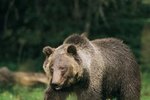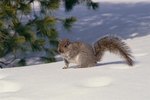
Historical reports suggest there were massive gray squirrel migrations in the United States during the 1800s. Nowadays, the gray squirrels who remain make regular migratory journeys, though nothing like in the past. Gray squirrels migrate just a few miles in their current primary range in the northeastern United States.
Gray Squirrel Habitat
Gray squirrels love nuts, so it's unsurprising that forests with an abundance of oak, hickory and beech trees provide squirrels with a perfect habitat. The squirrel loves collecting fallen nuts and burying them for consumption later. He likes an environment rich in berries and mushrooms, and he is partial to field crops such as corn. A significant mount of New England deciduous forest has been cleared for urban development, which has deprived the gray squirrel of abundant food sources. The availability of food sources is the primary reason for squirrel migration, according to the Connecticut Department of Energy and Environmental Protection.
Home Range
A gay squirrel's home range is typically between 2 and 7 acres, but it can extend to 100 acres. The size of the home range tends to change with the seasons and the availability of food, according to the MassAudubon website. The squirrels usually migrate in the fall in search of a better home. This migration usually doesn't extend beyond 50 miles; however, lack of food or lack of nesting places that protection against the winter weather may force the gray squirrel to travel further afield. Many squirrels are killed by road traffic during the fall migration.
Mass Migration
An area's squirrel population can change dramatically according to the website of the Connecticut Department of Energy and Environmental Protection. When food is abundant, the squirrel population increases; it decreases when food is in short supply. But lack of food is not the only cause of mass squirrel migrations. An abundance of food may cause squirrels to produce too many young, which causes migration. Several historical examples of mass gray squirrel migrations in the United States. In 1933, some 1,000 squirrels swam across the Connecticut River; during the 1800s observers spotted a series of southerly migrations from New England and the Midwest. One migration from Wisconsin in1842 lasted four weeks and involved some half billion squirrels.
Migration to the City
Gray squirrels are a familiar sight to city and town dwellers, as deforestation has forced the squirrels to migrate into urban areas. Gardens with bird feeders attract squirrels; in some areas they cause problems by invading homes through eaves and making homes in attics. From March to May and from August to September, such indoor nesting spots provides shelter during birthing seasons. Contact a wildlife authority for assistance with relocating squirrels from a house.
References
Photo Credits
-
Jupiterimages/Photos.com/Getty Images
Writer Bio
Based in London, Eleanor McKenzie has been writing lifestyle-related books and articles since 1998. Her articles have appeared in the "Palm Beach Times" and she is the author of numerous books published by Hamlyn U.K., including "Healing Reiki" and "Pilates System." She holds a Master of Arts in informational studies from London University.




